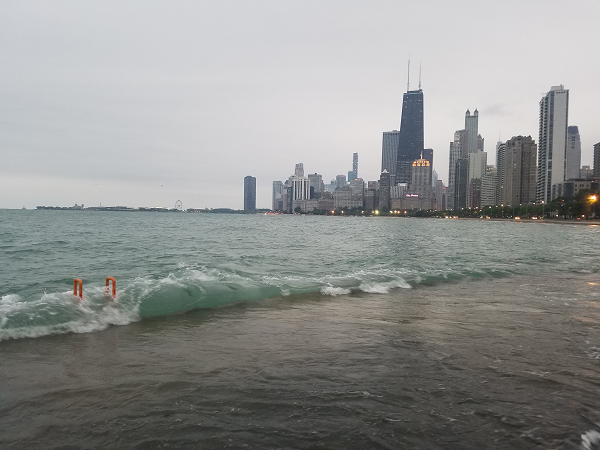Since 2007, Steve Hernan has gathered his Lake Monsters — a dedicated but lighthearted group of long-distance swimmers — each Saturday or Sunday morning at sunrise. They meet at what’s normally a beacon, the bright orange ladder near the Chess Pavilion, south of the North Avenue boathouse.
But this summer, the snapshots he posts on his Open Water Chicago blog look a little bit different: The ladder’s frequently covered by four to five inches of water.
“This is the highest lake level I’ve ever seen since I’ve been out there,” he says.
Indeed, Lake Michigan’s current water levels are its highest since October 1986’s record of 582.35 feet, per the U.S. Army Corps of Engineers. Forecasted levels for the week of August 16 were 581.79 feet.
The nearly unprecedented rise has been blamed for several boating accidents, some fatal. And combined with changes made in the recent Lakefront Trail Separation Project, the shifting shoreline has posed challenges for those using non-motorized transport in the water and along its 18 miles of uninterrupted parkland.
Some portions of the path are now submerged, causing issues for both swimmers and landlubbers. Others are dangerously slick. Several beaches — including Juneway and Fargo beaches in Rogers Park — have washed away entirely, with swimming there banned until further notice.
To address these issues, the Chicago Park District is working with the city, aldermen, and the Army Corps on a shoreline study for the entire lakefront starting in late August and continuing through mid-September, according to spokeswoman Irene Tostado.
The results will help identify strategies that can address erosion and storm damage, along with partners and resources to implement them, she says. In the meantime, the Park District has taken a few interim steps to warn swimmers and trail users of potential dangers.
As always, when the National Weather Service issues a beach hazard warning, the city also raises literal red flags to signal swimming isn’t safe. These alerts are also posted on the Chicago Park District website, plus its Facebook and Twitter pages.
Wooden sawhorses are placed along the Lakefront Trail when sections are deemed unpassable. They’ve appeared a few times between Oak Street and Ohio Street, where the pedestrian path has been nearly completely underwater most of the summer.
When it’s not closed entirely, runners and walkers have two choices in this section: hop on the concrete steps right next to Lake Shore Drive, or dodge cyclists on the portion of the path reserved for them, above the water level — a solution that poses serious collision risks, says Greg Hipp, executive director of the Chicago Area Runners Association.
Parts of the path that aren’t engulfed are often treacherously slick. About a month ago, the Park District began installing painted and permanent metal signs cautioning users about the slippery conditions between 6300 South and 4300 North Lakeshore Drive.
Trail users have also gotten creative. Hernan says some of his swimmers have taken to wearing beach sandals with treads, allowing them to step through the slime lining the concrete without falling.
Athletes preparing for next weekend’s Chicago Triathlon have also had to make some adjustments. At the race’s open-water swim clinics at Ohio Street Beach (the last one’s Tuesday), organizers are warning athletes about the newly treacherous conditions.
“You really can’t see that the natural barrier of the seawall there is gone,” says Scott Hutmacher, the brand manager for race organizer Life Time Tri. “If you’re not paying attention, you’re going to basically swim up onto the sidewalk.”
In Monroe Harbor, where the swim leg of the competition will be held on August 25, the water has also lapped over concrete steps. In the past, spectators have been able to stroll right up the seawall, practically close enough to touch swimmers. But this year, race officials will install extra fencing to hold them back.
“Because some of those sidewalks are now underwater, we want to discourage our spectators from actually stepping into the water and missing the ledge that drops into a 12-foot-deep section of Monroe Harbor,” Hutmacher says.
The fencing will also help swimmers spot the shoreline. And there’ll be more staff, lifeguards, and volunteer coaches on hand to make sure athletes don’t merely step out of the water, either.
“Without a wall there, that's a natural deterrent for them to keep moving,” Hutmacher says.
But competitors who decide to hop out not only risk injury from the metal plates protecting the sidewalk from the harbor — they’d also forfeit their medal.
“You need to complete the full swim, the full bike, and the full run course in order to be deemed a finisher,” he says.




